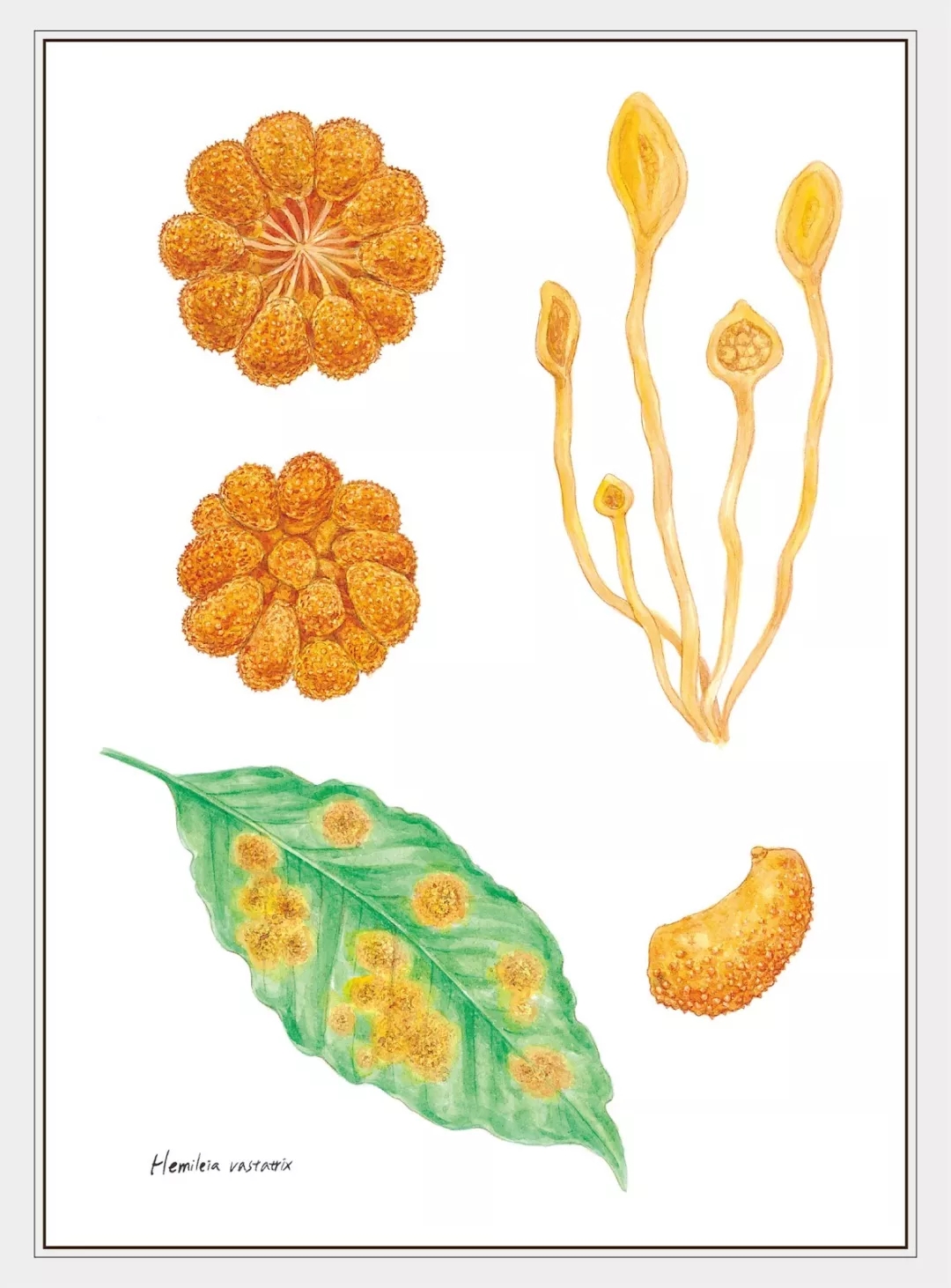Environmental upheaval expands the crisis! The mysterious "coffee camel spore rust" that could destroy the coffee industry.

Professional coffee knowledge exchange More coffee bean information Please pay attention to coffee workshop (Weixin Official Accounts cafe_style)
Author = Gu Xiaozhe (Ph.D., Fungal Cell Biology, University of Edinburgh, UK)
Plot = Lin Zhewei
Coffee is native to the tropical rainforests of southwestern Ethiopia in Africa. It may have been first used as a drink for medicinal and religious ceremonies, but its refreshing and refreshing qualities made it popular. Coffee houses were common in Egypt, Arabia and Turkey in 1500, and European tourists brought this strange flavor back to their countries. The Dutch saw the commercial potential of coffee and began growing it in their colonies of Sri Lanka, Sumatra and Java. Java actually means coffee.
Coffee Camelot Rust Causes National Disaster Botanists Can't Do Anything About It
By the early 17th century, coffee houses had sprung up in major European cities. Initially coffee represented the taste of the aristocracy and the wealthy, but it soon became popular among the general public, and coffee houses gradually became places where intellectuals from all over the world gathered to discuss philosophy, religion, and comment on politics.
When the Dutch ceded Sri Lanka to Britain in the 19th century, Sri Lanka had developed into the world's largest coffee-growing area. The British took over and doubled their development, planting coffee trees or small amounts of other cash crops such as rubber and cocoa beans on every inch of available land. Nearly 45 million pounds of coffee beans are exported each year, most of them destined for Britain. While coffee occupies a special place in Europe, coffee-growing regions are experiencing nightmares. In 1890, the good fortune of coffee farms in Sri Lanka finally came to an end.
Hemileia vastatrix is the main pathogen of coffee trees, causing coffee rust and a nightmare for the fragile coffee growing industry. Coffee rust was first discovered near Lake Victoria in West Africa in 1861, and began to appear in Sri Lanka in 1867, when Berkeley, the father of the fungus, identified it as coffee camel rust and gave it the frightening name vastatrix.
Whether the fungus originated in Ethiopia or was originally native to Sri Lanka remains a mystery. In 1879, coffee camel rust caused a national disaster, and the Sri Lanka government issued an appeal for Britain to send someone to solve the problem. A young botanist, Harry Marshall Ward, took up the challenge. Ward points out that the risk of widespread cultivation of coffee, for example, is that there are no windbreaks to buffer the spread of spores. He suggests using protective fungicides (a mixture of copper sulfate and hydrated lime) to prevent infection, as in bordeaux, france. But Ward's method was too late to save coffee.

Coffee camelot rust is a serious threat to our chances of waking up to make a hot cup of coffee or stopping by a cafe on our way to work. (Photo provided = Building block culture)
The fascinating rise of afternoon tea in Britain has something to do with coffee disease!
In 1890, the coffee industry in Sri Lanka was hit hard by coffee camel rust and collapsed. Within a few years, coffee rust spread to India, Sumatra and Java, and the center of coffee production shifted to Central and South America. Brazil became the world's leading coffee supplier, British farmers in Sri Lanka switched to tea, and afternoon tea culture began to flourish in Britain. Not only in Sri Lanka, but also throughout Southeast Asia, and finally throughout South Africa, Central Africa and West Africa coffee growing areas can be seen coffee rust traces. After a period of severe economic and social unrest, tea plantations replaced coffee plantations destroyed in Asia at the end of the 19th century, and the British switched to tea.
The coffee disaster is not over yet. Is the epidemic still spreading?
After coffee camelot rust destroyed the Asian coffee industry in 1890, it did not stop there. In the 1920s, it began to spread throughout Asia and Africa, and even to Indonesia and Fiji in the South Pacific. Eventually, by 1970, coffee rust had arrived in Brazil with coffee trees, and by 1975 it had spread rapidly throughout Brazil's coffee-growing regions.
After 1981, the epidemic spread to Central and South America. Colombia has 850,000 hectares of coffee, 41% of which is Coffea arabica, or Arabica. Arabica coffee is susceptible to coffee camelot rust, which caused 30 percent of crop losses in Colombia coffee fields in 1983. Environmental upheaval is the biggest driving force behind such a severe epidemic. The increase in rainfall and the decrease in sunshine due to dark clouds are all factors that make the disaster worse.
In Central America, 440,000 people lost their jobs in 2013 because the coffee industry was so hard hit. The humans, who are exhausted, are ready to flee the epidemic area with the coffee industry and turn to China, East Africa and Southeast Asia. This time, before coffee rust can catch up, humans have already given up.
crisis of variety unity
Almost all commercially produced coffee from the 19th and 20th centuries can be traced back to the same coffee tree-a coffee tree in King Louis XIV's greenhouse in 1713. Genetic uniformity in commercial coffee production was the trigger for devastating epidemics. So far, nine genes have been identified for disease resistance in wild coffee trees, but these genes come mainly from Coffea canephora (Canefora or Robusta) and Coffea liberica (Liberia), rather than commercially produced Arabica. Breeding coffee with rust resistance, high yield and high quality is a challenge.
At the same time, genetic diversity has been declining even in wild coffee, another disturbing development. Due to logging, heavy cultivation of fuelwood and population growth, the area of coffee diversity in southwestern Ethiopia in Africa has shrunk to less than a tenth of its original size. The Ethiopian government banned the export of coffee trees and seeds.
Article content, picture source: "Mushroom's history: from dining table, factory, laboratory, battlefield to farmland, fungi that human beings are obsessed with, dependent on or afraid of and their secret life," building block culture
Important Notice :
前街咖啡 FrontStreet Coffee has moved to new addredd:
FrontStreet Coffee Address: 315,Donghua East Road,GuangZhou
Tel:020 38364473
- Prev

Do I have to go to the end of hand coffee? What happens if you keep the end of the hand-brewed coffee?
Sometimes when baristas are brewing coffee, some baristas will remove the filter cup after all the water in the filter cup has flowed away, while others will choose to remove the filter cup when there is still water in the filter cup. What effect will this have on the flavor of the coffee? The editor is a little curious! So let's do an experiment today to see if there is a difference between keeping the water in the tail and removing the water in the tail.
- Next

What is the difference between hanging-ear coffee and black coffee? what are the characteristics of the brewing principle of hanging-ear coffee? what is the source of the story
Professional coffee knowledge exchange more coffee bean information Please pay attention to the coffee workshop (Wechat official account cafe_style) Black Coffee often heard that black coffee can lose weight, good for health, but what is black coffee? To put it bluntly, black coffee is a kind of coffee without any modification, which brings taste coffee.
Related
- Beginners will see the "Coffee pull flower" guide!
- What is the difference between ice blog purified milk and ordinary milk coffee?
- Why is the Philippines the largest producer of crops in Liberia?
- For coffee extraction, should the fine powder be retained?
- How does extracted espresso fill pressed powder? How much strength does it take to press the powder?
- How to make jasmine cold extract coffee? Is the jasmine + latte good?
- Will this little toy really make the coffee taste better? How does Lily Drip affect coffee extraction?
- Will the action of slapping the filter cup also affect coffee extraction?
- What's the difference between powder-to-water ratio and powder-to-liquid ratio?
- What is the Ethiopian local species? What does it have to do with Heirloom native species?

